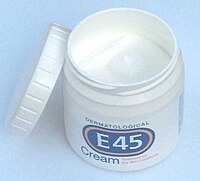
Photo from wikipedia
HYPOTHESIS One fundamental and unsolved question in colloid chemistry, and also in the food industry, is whether molecular distributions, specifically the interfacial concentrations of antioxidants (AOI), are independent of the… Click to show full abstract
HYPOTHESIS One fundamental and unsolved question in colloid chemistry, and also in the food industry, is whether molecular distributions, specifically the interfacial concentrations of antioxidants (AOI), are independent of the droplet sizes. Pseudophase kinetic models, widely employed to interpret chemical reactivity in colloidal systems and to determine antioxidant distributions, assume that they are independent. EXPERIMENTS To prove, or discard, the above hypothesis, we prepared and characterized a series of olive and fish oil-in-water nanoemulsions with different droplet sizes, carried out a kinetic study to evaluate their oxidative stability, both in the presence and absence of gallic acid (GA), and determined its interfacial concentrations. FINDINGS Results indicate that a change in the droplet size (80-1300 nm) does not alter the oxidative stability of the nanoemulsions in the absence of GA. Addition of GA increases their oxidative shelf-life and, at constant surfactant volume fraction, ΦI, the oxidative stability and the antioxidant distribution do not depend on the droplet size. Overall, results suggest that the droplet size does not affect the ratio between the rates of radical production and of inhibition by antioxidants, ratio that defines an "efficient" (or inefficient) antioxidant, providing experimental evidence supporting the operative assumption of pseudophase kinetic models.
Journal Title: Journal of colloid and interface science
Year Published: 2019
Link to full text (if available)
Share on Social Media: Sign Up to like & get
recommendations!